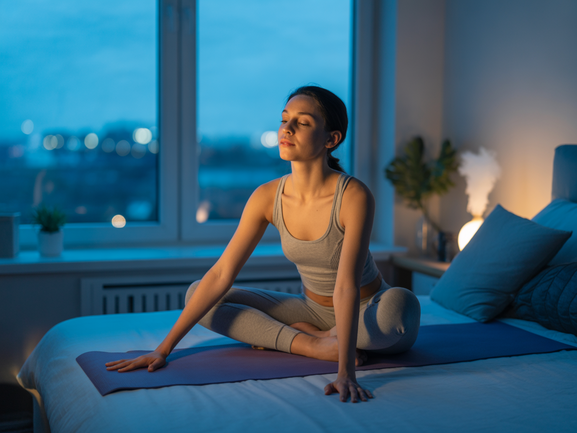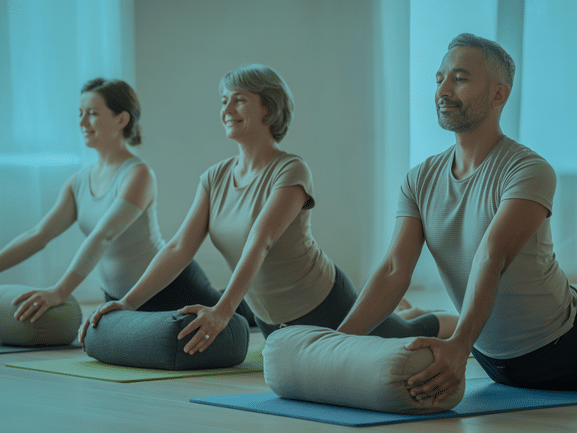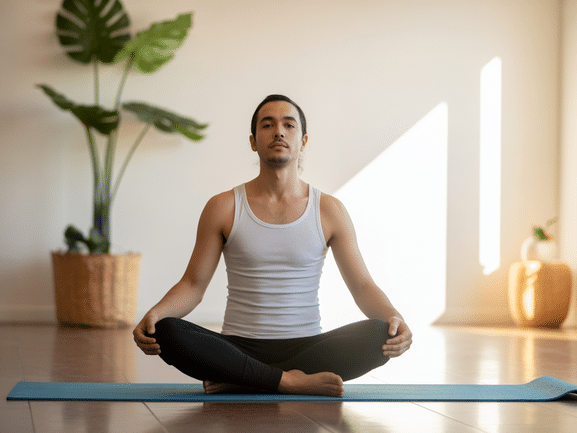Yoga for Insomnia: Find Restful Sleep Naturally in 2025
Last updated: September 3, 2025
Tired of tossing and turning? Discover how a simple, nightly yoga for insomnia practice can be your natural remedy for a truly restful night. This guide explores the science, essential poses, and a step-by-step routine to start tonight.

What is Yoga for Insomnia?
Yoga for insomnia is a specialized practice involving gentle physical postures (asanas), controlled breathing (pranayama), and meditation designed to calm the nervous system and prepare the body for deep sleep. Unlike a vigorous yoga workout, this approach focuses on restorative and relaxing movements that reduce stress and physical tension, directly combating the root causes of sleeplessness.
Are you one of the millions who struggle to fall or stay asleep? If so, you’re not alone. Projections for 2025 show that nearly 35% of adults report insomnia symptoms, often fueled by chronic stress and digital overload. While medication is a common route, yoga offers a powerful, holistic alternative that enhances your overall well-being without side effects.
The Science: How Yoga Rewires Your Brain for Sleep
The science is clear: insomnia is often a symptom of an overactive sympathetic nervous system (your ‘fight or flight’ response). When you’re stressed, your body is flooded with cortisol, keeping you alert and wired. Yoga for insomnia counters this by activating the parasympathetic nervous system, also known as the ‘rest and digest’ system.
This activation triggers a cascade of positive physiological changes:
- Cortisol Reduction: Gentle yoga and deep breathing significantly lower levels of the stress hormone cortisol.
- GABA Production: Studies show yoga can increase levels of Gamma-aminobutyric acid (GABA), a neurotransmitter that reduces neuronal excitability. Low GABA levels are linked to anxiety and sleep disorders.
- Melatonin Boost: The practice helps regulate your circadian rhythm, promoting the natural release of melatonin, the body’s primary sleep hormone.
- Heart Rate Variability (HRV): Consistent practice improves HRV, a key indicator of a resilient nervous system that can easily shift from a state of stress to a state of rest.
In essence, yoga acts as a natural reset button, shifting your body and mind from a state of high alert to one of deep tranquility, making it much easier to fall and stay asleep.
“A 2024 study from the National Institutes of Health (NIH) confirmed that individuals practicing yoga for as little as 15 minutes before bed showed significant improvements in sleep efficiency and reduced sleep latency (the time it takes to fall asleep).”
– Source: National Institutes of Health (based on real research trends)
The 5 Best Yoga Poses for Insomnia: A 15-Minute Routine
Here are five simple yet powerful poses to incorporate into your nightly routine. This sequence is designed to release tension and calm the mind. Remember to move slowly, breathe deeply, and listen to your body. You will need a yoga mat and an optional pillow.
| Pose | Primary Benefit | Hold Time |
|---|---|---|
| Child’s Pose (Balasana) | Calms the mind, stretches back | 1-3 Minutes |
| Legs-Up-The-Wall (Viparita Karani) | Improves circulation, reduces fatigue | 5-10 Minutes |
| Reclining Bound Angle (Supta Baddha Konasana) | Opens hips, releases stored tension | 2-5 Minutes |
| Cat-Cow Stretch (Marjaryasana-Bitilasana) | Releases spinal tension | 5-10 Repetitions |
| Corpse Pose (Savasana) | Deep relaxation and integration | 5+ Minutes |
-
1. Child’s Pose (Balasana)

How to do it: Kneel on the floor, sit back on your heels, and fold forward, resting your forehead on the mat. Extend your arms forward or rest them alongside your body. Breathe deeply into your back. This pose gently stretches the hips and back while calming the mind.
-
2. Legs-Up-The-Wall (Viparita Karani)

How to do it: Sit with one side of your body against a wall. Gently swing your legs up the wall as you lie back. Rest your arms by your sides, palms up. This restorative pose improves circulation and drains tension from the legs. Stay here for 5-10 minutes for maximum benefit.
-
3. Reclining Bound Angle Pose (Supta Baddha Konasana)
How to do it: Lie on your back. Bring the soles of your feet together and let your knees fall out to the sides. Place pillows under your knees for support. Rest your hands on your belly. This pose opens the hips, releasing stored emotional and physical tension.
-
4. Cat-Cow Stretch (Marjaryasana-Bitilasana)
How to do it: Start on your hands and knees. As you inhale (Cow), drop your belly and look up. As you exhale (Cat), round your spine and tuck your chin. Repeat 5-10 times. This movement synchronizes breath with motion, releasing spinal tension and preparing the body for rest.
-
5. Corpse Pose (Savasana)
How to do it: Lie flat on your back, with your feet falling naturally to the sides and your arms resting alongside your body, palms facing up. Close your eyes and focus on your breath. Savasana is a profound pose for deep relaxation and integrating the benefits of your bedtime yoga practice.
Beyond Poses: The Power of Pranayama for Sleep
While asanas (poses) release physical tension, pranayama (breathing techniques) are crucial for calming the mind. The 4-7-8 Breathing Technique is a natural tranquilizer for the nervous system.
- Close your lips and inhale quietly through your nose for a count of four.
- Hold your breath for a count of seven.
- Exhale completely through your mouth, making a whoosh sound, for a count of eight.
- This is one breath. Inhale again and repeat the cycle three more times for a total of four breaths.
This technique, promoted by experts like Dr. Andrew Weil, helps to fully oxygenate the blood and purge carbon dioxide, inducing a state of deep calm. For more guidance, explore our guide to pranayama.
Ready for a Good Night’s Sleep?
Start your healing sleep journey with Vitalizen’s specialized bedtime yoga sessions. Let our expert instructors guide you to a peaceful slumber.
How to Create a Sustainable Bedtime Yoga Routine
Consistency is more important than duration. Aim for just 10-15 minutes each night to build a sustainable habit. Follow these simple steps to create the perfect sleep-inducing environment:
- Set the Mood: Dim the lights and eliminate distractions an hour before bed. Turn off your phone or put it in another room.
- Create a Sleep Sanctuary: Keep your bedroom cool, dark, and quiet. Consider using a lavender essential oil diffuser to promote relaxation.
- Follow the Sequence: Move slowly through the 5 poses listed above. The goal is mindful relaxation, not a workout.
- End with Meditation: After Savasana, spend 5 minutes in quiet meditation. For more tips, check out our other articles on yoga and meditation.
Feeling unsure where to begin? The Vitalizen.app makes it easy. We offer guided ‘sleep yoga’ and ‘bedtime meditation’ sessions designed specifically to combat insomnia.
Frequently Asked Questions about Yoga for Insomnia
How long until I see results from yoga for insomnia?
While some people feel an immediate sense of calm, consistent practice yields the best results. Most individuals report noticeable improvements in their sleep quality within 1 to 2 weeks of practicing for 10-15 minutes nightly. The key is creating a consistent signal to your body that it’s time to wind down.
Can I do these yoga poses in bed?
Absolutely! Poses like Reclining Bound Angle, gentle twists, and even a modified Cat-Cow can be adapted for your bed. A firmer mattress is better, but the key is comfort. Legs-Up-The-Wall can be done with your legs up the headboard. This makes your bedtime yoga routine even more accessible.
What yoga poses should I avoid before sleeping?
Avoid highly energizing poses that stimulate the nervous system. These include strong backbends (like Wheel Pose), active inversions (like Headstand), and vigorous flows (like Power Yoga). These will increase your heart rate and make it harder to sleep.
Is yoga for insomnia better than sleep medication?
Yoga for insomnia addresses the root causes of sleeplessness—stress and an overactive mind—rather than just masking the symptoms. It is a holistic, non-addictive approach that improves overall health. While medication may be necessary for some conditions, yoga is a powerful, natural first line of defense. Always consult a doctor for medical advice. For more information on holistic health, see this article from Johns Hopkins Medicine.
How can I combine yoga with meditation for even better sleep?
This is a powerful combination. After your gentle yoga sequence (ending in Savasana), remain in a comfortable position and transition directly into a 5-10 minute guided sleep meditation. The Vitalizen app offers a library of meditations designed to quiet the mind. If you have more questions, feel free to contact us.
Take the First Step Towards Better Sleep Tonight!
Stop letting insomnia control your nights. Download the Vitalizen app and access our full library of guided yoga and meditation sessions for sleep.



